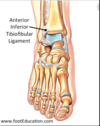1. Anatomy Flashcards
(74 cards)
how many bones are in the foot?
26
(*not including sesamoids)
how many joints are in the foot?
35
name the accessory ossicle:
between 1st cuneiform and 1st & 2nd metatarsal bases
os intermetatarsium
name the accessory ossicle:
proximal 5th metatarsal base
os vesalianum
name the accessory ossicle:
accessory navicular
os tibiale externum
name the accessory ossicle:
dorsal aspect of navicular
os supranaviculare
name the accessory ossicle:
sesamoid bone in PB tendon
os peroneum
name the accessory ossicle:
dorsal, anterior process of calcaneus
os calcaneus secondarius
name the accessory ossicle:
posterior aspect of sustentaculum tali
os sustentaculi
name the accessory ossicle:
posterior aspect of talus (Steida process)
os trigonum
name the accessory ossicle:
distal to medial malleolus
os subtibiale
name the accessory ossicle:
distal to lateral malleolus
os subfibulare
name avascular necrosis of:
tibial sesamoid
Renandier
name avascular necrosis of:
fibular sesamoid
Trevor
name avascular necrosis of:
phalanges
Theiman
name avascular necrosis of:
metatarsal heads
Freiberg
name avascular necrosis of:
5th metatarsal base
Iselin
name avascular necrosis of:
cuneiforms
Buschke
name avascular necrosis of:
navicular
Kohler
name avascular necrosis of:
cuboid
Lance
name avascular necrosis of:
talus
Diaz
name avascular necrosis of:
calcaneus
Severe (?)
name avascular necrosis of:
proximal, medial tibial epiphysis
Blount
name avascular necrosis of:
tibial tuberosity
Osgood-Schlatter











